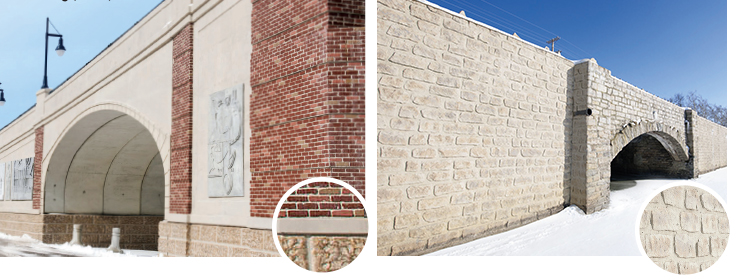Some people’s careers follow a narrow, straight path. Follow how one pro’s road of twists and turns helped her become a sought-after decorative concrete expert.
A former art school student who had worked many years in the medical field, Roni Basler was looking for a change when her brother — the owner of an architectural stamped-concrete franchise — suggested she come help handle the books for his growing business. But when she arrived for work, her sibling gave her a surprise.
A Product for Reconstruction Gone Right
Basler’s team used H&C® Concrete Stain Solid Color Water-Based, which bonds to concrete and forms a tough shield so it doesn’t fade, peel or flake like paint. It is resistant to acids, ultraviolet rays, oil, gas and alkali while maintaining a decorative finish.
“He said, ‘You’re going to learn to do concrete from the ground up,’” Basler recalls. “So, here I am out on a job site, learning how to set up forms, cut wire mesh, throw color hardener, and do everything in different types of weather. About that time I started to wonder what I’d gotten myself into.”
Nearly 15 years later, that turn in the road led Basler to launch Artistic Rock, LLC, a decorative-concrete business specializing in selling form liners and staining the concrete shapes created with them on large-scale projects, such as bridges, overpasses or retaining walls. Because of her early background as a crew member on heavy concrete projects, she can not only plan and estimate a job, but also handle the on-site work. While those skills have taken her to jobs all over the country, a sizable part of her business is located in her home state of Ohio. Here’s a quick look at two challenging decorative concrete projects.
Starting with mockups
The Mill Street Bridge project in Akron, Ohio (see top left), involved removing and reconstructing a bridge in the city’s historic Quaker Square area, and Basler successfully bid the decorative concrete staining work. An early challenge was getting key stakeholders — including the city of Akron, University of Akron and the Ohio Department of Transportation (ODOT) — to reach consensus on a stain color to be applied to a used-brick pattern on the bridge piers. Once that was settled, Basler tapped Chris Fell, manager of the Sherwin-Williams store in nearby Richmond Heights, Ohio.
“The client wanted on-site mockups of the final color choice, so I gave Chris some brick samples to work with,” Basler says. “He spent some time playing with the colors and ultimately got just what I needed.” When work began, the prime contractor installed form liners along the bridge’s walls to give the concrete exterior its stone- and brick-shaped appearance. After the concrete was poured into the form liners and cured, Basler’s team used H&C® Concrete Stain Solid Color Water-Based to add the desired colors in each area — 10,000 square feet of concrete in 18 days.
This feat was even more impressive due to the mid-October weather conditions. “Typically, you don’t want to do decorative stain work like this with surface temperatures under 50 degrees,” Basler says. “We often had to wait for the sun to warm things enough to work each day.”
Spanning old and new
The bridge and retaining wall near Columbus, Ohio (see top right), presented several challenges. For example, while this was technically a new bridge installation, local officials wanted to preserve an existing sandstone archway of the original span. That meant Basler needed to supply existing stone so the manufacturer could produce an architectural form liner design that would help new concrete piers and retaining walls mimic the existing stone surface. Once the form liner design was approved and a concrete mockup was created, Basler worked through a half-dozen concrete stain samples before reaching agreement on the shade with county engineering staff.
After the molded concrete facings had cured and were pressure-washed, Basler faced a second challenge: how to apply concrete staining products over a river span too deep to wade. County officials rigged up a safety harness and placed Basler in an earth mover bucket, where she knelt to spray a base coat of H&C Concrete Stain Solid Color Water-Based, followed by sponge applications of approved highlight colors. When complete, Basler says, it was virtually impossible to tell the difference between old stone and new concrete. “If you look at the original sandstone arch and the decorative concrete installed next to it, you can’t tell any difference in appearance unless you’re standing just a couple of feet away.”




